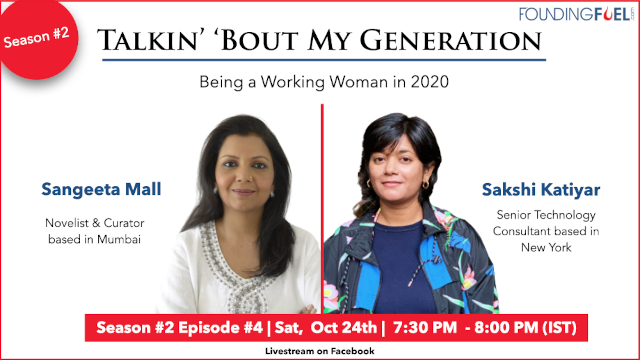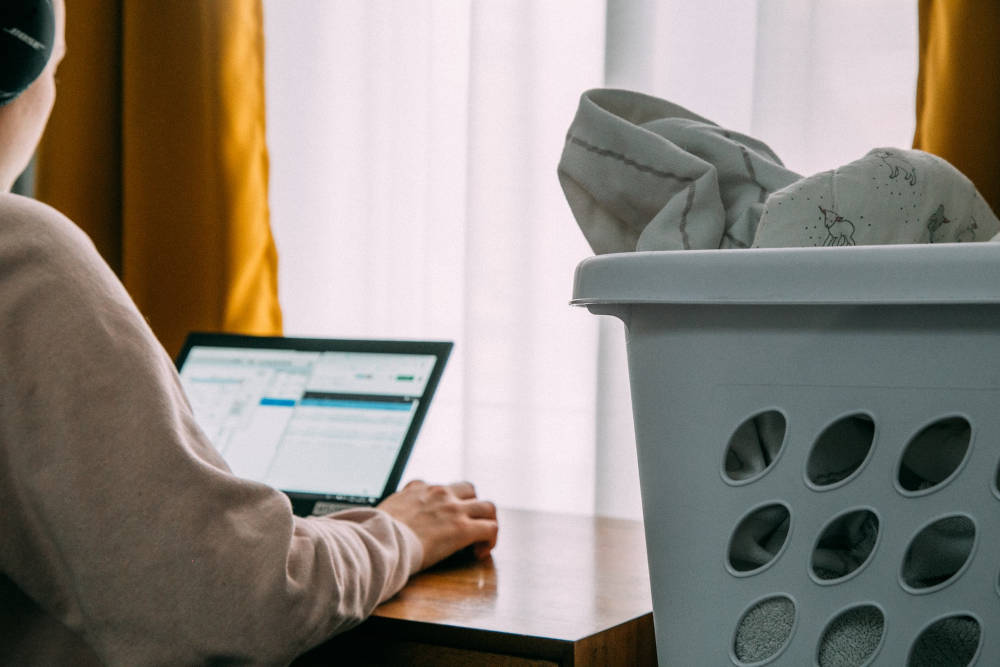[Photo by Charles Deluvio on Unsplash]
By Sakshi Katiyar and Sangeeta Mall
It is Monday morning and I have already been in meetings for three hours. I am cooped up in my tiny New York City apartment, at a makeshift desk in my living room, missing my office’s stunning Manhattan view and state-of-the-art coffee machine. These days, I often wonder if I can remember what my colleagues’ voices sounded like when not fed through a device. Oh, what I would give for just ten minutes of completely banal small talk in my office’s break room! Meanwhile, back at home, I rinse the sad instant coffee out of my mug, load it into the dishwasher, hit the on button and…nothing happens. I fiddle around with it a bit and it still won’t turn on. I turn to my partner and ask him if he could call the technician to come in and take a look. Without lifting his head from his phone, he says, “You do it na!” So now, on top of pressing deadlines at work, I have a broken dishwasher to deal with.
Working women all over the world are familiar with this dual role—managing a career as a working professional while simultaneously also managing a household. As more women have entered the workforce, the stress of the double-duty has become widespread. At work, she may have to lead meetings, supervise teams, and pitch for new business. At home, she is the primary caregiver for children as well as older family members. She is responsible for putting food on the plate, managing a home’s finances, and supervising household staff. From packing a tiffin to helping with homework—the trope of the superhero mom isn’t hyperbole when you consider the sheer volume of responsibility on her shoulders.
But while many, mostly men, are celebrating the new post-pandemic workplace—an uber-efficient, virtual, untethered new era of work, they would have you believe—I am far more wary. For many women like me, work, and the routine it created, served as neat lines that helped us compartmentalize our daily lives. My commute, much like Clark Kent’s telephone booth, was my space to transform from the domestic wife and daughter into the professional tech analyst and consultant. In my office, I felt empowered by a corporate culture that valued my talent and opinions. The gym was my solace from other people, a space of my own to burn away my frustration and get stronger. I looked forward to my train rides back home where I would listen to my favourite podcast or catch up on some reading, uninterrupted.
All of these spaces have now merged into one and after a few months of this new reality, women are feeling the pain more than ever before. The corporate hierarchy women participate in is far more accustomed to their individuality, and their peers and seniors at work not just appreciate but expect their opinion on various matters. Social hierarchy at home, meanwhile, is not so forgiving. As a woman in an Indian family, my domestic role is hardcoded into all of our rituals and traditions. In many ways, I am lucky where I currently don’t have children or elderly family members who need my care and attention. Here in the US, I see my colleagues struggling to cope with the shutdown of schools and daycare services. In an attempt to cope, many Americans are turning to the joint family model, where grandparents—if not stranded in a nursing home—can step in to help with the kids.
There are early signs that this overload may already be setting back years of progress made towards gender equity. According to a recent survey by McKinsey and LeanIn.org, one in five working mothers are considering dropping out of the workforce, compared with 11% of fathers. The number jumps up to nearly 25% for women with young children. Even pre-Covid, working women found it a challenge to navigate the workforce after having children. Former PepsiCo CEO Indra Nooyi, referring to the reducing number of women as you move up the ranks in a company, called it a “pipeline problem”. Women equal men in number in the lower-ranking, entry-level roles. But the age at which you shoot up the career ladder coincides with the child-rearing age for women, leading to many women dropping out of the workforce. The pressure of the post-Covid workplace threatens to rip the leak in Nooyi’s pipeline into a gigantic chasm.
In my industry, I work with talented women capable of leading the company if provided with the right support, both at work and at home. Yet, even at this early stage in my career, I have seen women make the hard decision to exit the workforce to care for their families. This decision is further justified by the disparity in compensation and leadership opportunities between men and women. That said, corporations are aware of this ‘leak’ of talent and many are attempting a fix by extending vacation time, reimbursing day care fees, and providing funds for setting up a home office. Managers and leaders are eager to provide their teams with greater schedule flexibility so that they may access some much-needed bandwidth to juggle their various responsibilities. Last month Google announced a “hybrid” work-from-home model where employees can choose when they want to come into the office. Meanwhile, Twitter announced that it will let their employees work-from-home ‘forever’. Leading Indian technology consulting company TCS is also ramping up its IT infrastructure to enable the majority of its employees to work remotely by 2025. These changes benefit not just working women but men as well.
Informally, women are checking-in on each other over virtual meet-ups to ensure they have a support system. Fathers are taking on childcare and household tasks in far greater capacity today than pre-pandemic. Earlier in the year, when the lockdown was still a new concept, I saw some of my female colleagues begging for empathy and consideration through auto-replies in their inbox. I especially remember one that said ‘I am juggling between the role of a teacher, parent, wife, cook and house-keeper. Please expect a delay in my response.’ Fast-forward six months and over a virtual coffee the same colleague tells me that she has made it alive through it all and has her empathetic boss, team mates, and husband to thank. They came together to alleviate her pain during this challenging time and a few months into the new normal, she has finally found an agreeable rhythm to her day. The pandemic has introduced a much-needed human element to work where it’s now acceptable to run a personal errand in the middle of the day so long as tasks get done before the deadline.
Dishwasher-incident notwithstanding, I am glad that my partner is handy around the house and that like him, many men of my generation expect to share the load of maintaining a home, an idea the older generation is still getting used to! On my mother’s last visit to New York, we decided to take a break from sight-seeing and have a day in to eat a home-cooked meal. Mom cooked us my favourite, chhole-puri, and decided to put up her feet for a minute before returning to the pile of dishes. As she returned to the kitchen, she was aghast at what she saw: my husband was already doing the dishes! It was incomprehensible, almost unacceptable, to her that her son-in-law was cleaning up but since then, we have come a long way where now my mother deeply appreciates this very quality in my husband. This incident reminded me of the shielded upbringing of most Indian men but at the same time, showed both my mother and I a glimpse into a more equitable future, at least within the modern home.
For millennials like me, the pandemic has flashed a light upon the difference that a more egalitarian society can make to the economy. The men of my generation are culturally more attuned to pulling their weight at home, with redeeming consequences for both professional and personal relations. While the road to equality at home is still very long, nonetheless 2020 has certainly given society a bumper push in that direction.
The last few months have been great as my partner and I snuck in occasional lunches together, and I revelled in the discovery that laundry need not be restricted to weekends. But a part of me yearns to return to the hustle of the streets of New York and for a few hours at least, forget about that broken dishwasher.
Sangeeta Mall: “Housebreaking the male of the species must become a joint enterprise”
“The twin roofs of office and home are merged, while reducing none of the tasks that women have historically taken care of,” says Sangeeta.
“Sakshi’s generation is hardwired to bring equality into domestic life. But the pandemic has injected this gene into the older generation now,” she adds.
Listen to her take, or read the edited transcript below.
Edited transcript:
As a writer, I’m used to working from my desk at home. But a few years ago I couldn’t resist the urge to play ‘office-office’, so I hired a co-working space, a cubicle one fifth the size of my room at home, for the pleasure of drinking endless cups of industrial coffee as I made uninterrupted calls from my desk, secure in the knowledge that no pebble of domestic irritant was going to enter my work shoe. I’m not sure if my productivity in those few hours went up, but splitting the conjoined twins of work and home gave me a new life.
When I read Sakshi’s piece, I’m reminded of Jean-Baptiste Alphonse Karr’s immortal words ‘Plus ca change, plus ce la meme chose’ [The more it changes, the more it is the same thing]. It was never more true than for women in 2020. The pandemic has merged the twin roofs of office and home while reducing none of the tasks that women have historically taken care of from the beginning of time. While men revel in the relief of saving on endless commutes, and taking quick breaks to catch up on the latest sports tournaments in between meetings, women are caught between the rock of office work and the hard place of childcare, kitchen duties and overall homemaking. The blow is hardest for women with children in age 0 to 12. The pandemic has moved the responsibility of supervising the kids’ school life in addition to their home life onto the parents, mostly mothers. This is the cohort that’s most likely to fall off the work wagon, Covid notwithstanding. It’s the one responsible for the drop from 47% of the workforce at entry level to 7% at partner level in a consulting firm, as one of the few female partners shockingly revealed.
But, of course, things do change. The home is learning to be kinder to women. Sakshi’s generation is hardwired to bring equality into domestic life. But the pandemic has injected this gene into the older generation now. While being nowhere close to the sensibility of the millennials, men and women are learning to recognise the importance and value of men being equal partners at home. All this while, society was grappling with agricultural and industrial era norms of gender parity. The pandemic has conclusively overturned these, and brought men inside the home. In the Indian context, when the domestic help was cut off for weeks on end, one of the most exciting purchases by middle class men was a state-of-the-art vacuum cleaner. Going forward, if this change is not to be a flash in the pan, both men and women have to learn to adapt. No organisation can grow without the right training, so also, no home. Those fumbling efforts at feeding the baby need to be encouraged, not mocked. Housebreaking the male of the species must become a joint enterprise!
Organisations are also growing up where gender disparity is concerned. As the laptop screen replaces physical distance, companies can no longer hold up the constraints of location, safety and timings to avoid hiring females. The zero sum game of either work or home is now giving way to work and home together. The industrial era framework of nine to five is gradually yielding to the digital era zero to midnight clock, giving women substantially more flexibility to don the superwoman tights. 2020 has shoved the world into the technological age, and women stand to benefit the most.
Sakshi’s climb to senior partner will have far fewer boulders. In that sense, the pandemic notwithstanding, 2020 might become the year when the world becomes stronger because its women became stronger.
Sakshi and I will be in conversation on this theme live on Facebook on Saturday, Oct 24 at 7.30 pm. Do join us by registering on the link below. See you there!

If you haven’t registered to watch the show already, register here: https://bit.ly/FFTAMG
In the meantime, here’s a playlist of Season 1, E01-07.
Bookmark the series. (The show is supported by a column on Founding Fuel, and an ongoing conversation with the Founding Fuel community on our Slack channel.)
Still Curious?
-
Read Resurgent women: The times they are a changin’, an extract from Anirudha Dutta's book Half a Billion Rising, where he talks about how the coming decade will see more educated women entering the workforce, the far-reaching socio-economic implications, and how men will have to respect and adapt to live with these changes.
-
Read Lockdown notes on working, living and loving from the Far East. Kavi Arasu’s observations on how professionals across China and the Far East are picking up the pieces of their lives and getting back to work. But it isn’t quite the same again.



